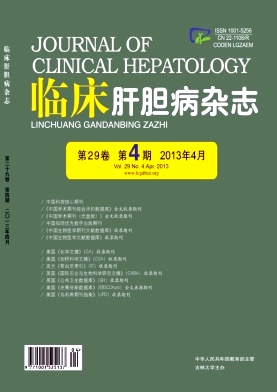Objective To evaluate whether perturbed concentrations of serum β2-microglobulin (β2-MG) and cystatin C (CYS C) due to renal damage can accurately reflect liver diseases in different stages.Methods Between 2010 and 2011, 125 consecutive patients diagnosed with hepatitis B virus (HBV) infection were enrolled for study, including 55 patients with chronic hepatitis, 38 patients with cirrhosis, and 32 cases of chronic severe hepatitis;patients were tested to rule out other diseases that may cause elevated β2-MG and/or CYS C.Fifty-five healthy individuals were recruited for the control group.After an 8 h fast, measurement of serum β2-MG and CYS C was made by the latex-enhanced turbidimetric immunoassay, and of serum creatinine (SCr) by enzymatic assay.Significance of intergroup differences was assessed by the statistical t-test.Results As compared to the control group, the chronic hepatitis group showed similar levels of serum CYS C ( (0.86±0.23) mg/L vs. (0.90±0.28) mg/L, t=0.82, P>0.05) , but significantly enhanced serum β2-MG ( (1.02±0.89) mg/L vs. (1.35±0.78) mg/L, t=2.07, P<0.05) .However, both the liver cirrhosis and severe hepatitis groups showed significantly enhanced levels of serum CYS C (vs.cirrhosis: (1.35±0.38) mg/L, t=7.75, P<0.01;severe hepatitis: (3.02±1.56) mg/L, t=10.12, P<0.01) and β2-MG (cirrhosis: (2.35±1.23) mg/L, t=6.05, P<0.01;severe hepatitis: (4.35±0.98) mg/L, t=16.21, P<0.01) .Only the severe hepatitis group showed a significant difference (enhanced) in levels of SCr as compared to the control group ( (128±38) μmol/L vs. (82±23) μmol/L, t=7.04, P<0.01) .Conclusion Levels of serum CYS C and β2-MG are enhanced during hepatitis and may be a useful diagnostic indicator of early liver disease with greater sensitivity than SCr.Although serum β2-MG was more sensitive than CYS C, its concentration may be affected by more factors, so the measurement of both β2-MG and CYS C may be necessary when developing an effective clinical or investigative method to monitor the course of renal damage caused by liver diseases.













 DownLoad:
DownLoad: